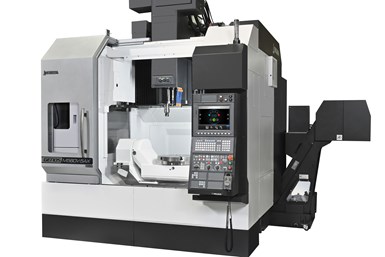Okuma America Double-Column VMC Features Compact Footprint
The new Genos M560V-5AX offers a working envelope with a 500 mm table and wide axis travels, while still maintaining a compact footprint of 2,515 mm × 3,750 mm.
Okuma America Corporation’s Genos M560V-5AX is built with a double-column machine design, affording it maximum structural integrity. The machine offers a working envelope with a 500-mm table and wide axis travels (X: 1,050 mm, Y: 560 mm, Z: 460 mm), while still maintaining a compact footprint of 2,515 mm × 3,750 mm.
The Genos M560V-5AX features a trunnion table positioned parallel to the front of the machine, which enables easier access to the table and good visibility during machining. This, and other user-friendly features on the machine, reduce physical burden on the operator. Additionally, the machine comes standard with a 60-tool automatic tool changer (ATC) magazine and can also accommodate tools measuring up to 400 mm in length.
The Genos M560V-5AX comes standard with Okuma’s Thermo-Friendly Concept, an on-board thermal and energy management technology to support both stable, high-accuracy machining and reduce energy consumption.
Key Specs of the Genos M560V-5AX vertical machining center include:
- Table Size: 500 mm
- Max Workpiece Dimensions: 700 × 500 mm
- Spindle Maximum Speed: 15,000 min⁻¹
- Spindle Motor Power: 22/18.5 kW
- Axes Travel: 1,050 mm (X-axis), 560 mm (Y-axis), 460 mm (Z-axis)
- Floor Space: 2,515 × 3,750 mm (w × d)
- Weight: 10,000 kg
With its versatility and five-axis cutting capabilities, Okuma says the Genos M560V-5AX provides shops with the ability to expand their operational possibilities.
Related Content
-
Orthopedic Event Discusses Manufacturing Strategies
At the seminar, representatives from multiple companies discussed strategies for making orthopedic devices accurately and efficiently.
-
Quick-Change Tool Heads Reduce Setup on Swiss-Type Turning Centers
This new quick-change tooling system enables shops to get more production from their Swiss turning centers through reduced tool setup time and matches the performance of a solid tool.
-
5 Tips for Running a Profitable Aerospace Shop
Aerospace machining is a demanding and competitive sector of manufacturing, but this shop demonstrates five ways to find aerospace success.

















